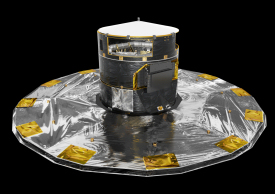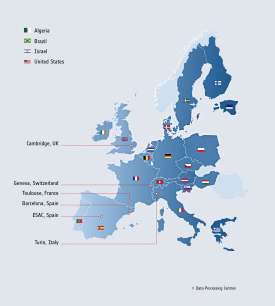Gaia data processing consortium meets ahead of first catalogue release next year
16 November 2015
From 16 to 20 November 2015, about two hundred members of the Gaia Data Processing and Analysis Consortium (DPAC) are meeting in Leiden, The Netherlands, to review the current status of preparations for future catalogue releases from ESA's billion star surveyor mission.
 |
| Gaia spacecraft. Credit: ESA/ATG medialab |
Launched in December 2013, ESA's Gaia satellite started routine scientific operations on 25 July 2014. As it scans the sky from its location at the L2 Lagrange point, Gaia records the position, brightness, and colours of any object brighter than 20th magnitude that crosses its field of view.
During its five-year nominal mission, this will amount to positions of a billion stars in our Milky Way galaxy from which their distances and motions can be reconstructed with unprecedented accuracy. The brightness and colour measurements provide the information needed to determine the luminosity, temperature, composition and other physical characteristics of most of these stars. This huge stellar census will provide a foundation for tackling an enormous range of important problems related to the origin, structure and evolutionary history of our Galaxy.
By now, Gaia has accumulated about 340 billion positional or astrometric measurements, 68 billion brightness or photometric data points, and 6.7 billion spectra. Each of these data points is associated with a celestial object that passed across the Gaia focal plane during a scan. But this in itself is not sufficient to produce the absolute astrometric parameters – position, parallax and proper motion – that are the ultimate goal of Gaia. These parameters can only be obtained by solving a complex mathematical and numerical framework that finds the best fit for the data and provides a satisfactory global astrometric solution. For the brightest stars of the sample it is possible to add yet another kinematic piece of information, when the radial velocity is extracted from the observed spectra.
Disentangling these data and determining the solution is therefore a huge task in terms of expertise, effort and dedicated computing power. In 2006, the Data Processing and Analysis Consortium (DPAC), a large pan-European team of expert scientists and software developers, was given the task of preparing for, and producing the Gaia catalogues.
 |
| Participation in DPAC. Credit: ESA |
The consortium consists of nine coordination units (CU), each focussing on a particular set of data processing tasks. In turn, the coordination units are supported by six data processing centres (DPC) hosting the computer hardware needed for the work.
Now, after more than a year of routine science operations and with over one-quarter of the total data expected for the five-year mission already to hand, DPAC members are in an ideal position to take stock of their achievements to date and to prepare for the next major milestones, in particular, the first Intermediate Data Release. This catalogue will be based on data from the first year of Gaia's observations, and the current release scenario foresees its publication in 2016 (details can be found here).
Although the individual CUs and DPCs hold regular meetings and teleconferences, and discuss their work collaboratively on a variety of platforms, the meeting in Leiden will provide them with a rare opportunity to share and discuss their work face-to-face with colleagues from all the other units within the consortium.
On the agenda are several plenary sessions to present the current status. There will also be a number of splinter sessions dedicated to specific data processing topics, during which the scientists will have a chance to work with one another and iron out possible issues that have emerged during the past year, all with the aim of meeting the goal of the first intermediate catalogue result next year.
Contacts
Timo Prusti
Gaia Project Scientist
European Space Agency
Email: timo.prusti![]() esa.int
esa.int
Anthony Brown
Chairperson of the Gaia Data Processing and Analysis Consortium Executive (DPACE)
Leiden Observatory, Leiden University
Leiden, The Netherlands
Email: brown![]() strw.leidenuniv.nl
strw.leidenuniv.nl


